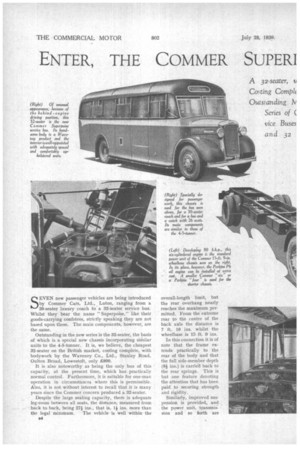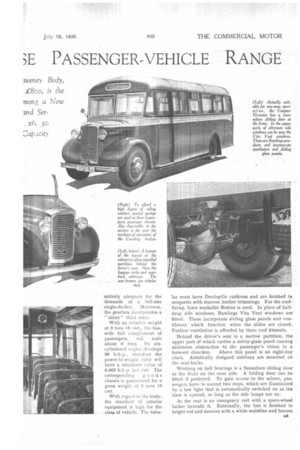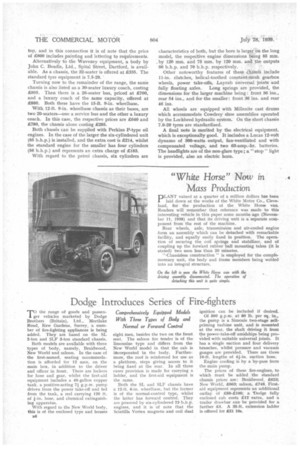ENTER, THE COMMER SUPERI ;E PASSENGER-VEHICLE RANGE
Page 38

Page 39

Page 40

If you've noticed an error in this article please click here to report it so we can fix it.
SEVEN new passenger vehicles are being introduced by Commer Cars, Ltd., _ Luton, ranging from a 20-seater luxury coach to a 32-seater service bus. Whilst they bear the name " Superpoise," like their goods-carrying confreres, strictly speaking they are not based upon these. The main components, however, are the same.
Outstanding in the new series is the 32-seater, the basis of which is a special new chassis incorporating similar units to the 4-5-tonner. It is, we believe, the cheapest 32-seater on the British market, costing complete, with bodywork by the Waveney Co., Ltd., Stanley Road, Oulton Broad, Lowestoft, only £800.
It is also noteworthy as being the only bus of this capacity, at the present time, which has practically normal control. Furthermore, it is suitable for one-man operation in circumstances where this is permissible. Also, it is not without interest to recall that it is many years since the Commer concern produced a 32-seater.
Despite the large seating capacity, there is adequate leg-room between all seats, the distance, measured from back to back, being 271 ins., that is, li ins, more than the legal minimum. The vehicle is well within the s4
overall-length limit, but the rear overhang nearly reaches the maximum permitted. From the extreme rear to the centre of the back axle the distance is 7 ft. 10 ins, whilst the wheelbase is 15 ft. 9 ins.
In this connection it is of note that the frame extends practically to the rear of the body and that the full side-member depth (8i ins.) is carriea back to the rear springs. This is but one feature denoting the attention that has been paid to securing strength and rigidity.
Similarly, improved suspension is provided, and the power unit, transmission and so forth are
entirely adequate for the demands of a full-size single-decker. Moreover, the gearbox incorporates a "
silent" third ratio.
With an unladen weight of 3 tons 38 cwt., the bas, with full complement of passengers. will scale about 6 tons. Its sixcylindercd (mgine develops 80 b.h.p., therefore the power-to-weight ratio will have a minimum value of 0.665 b.h.p. per cwt. The corresponding goods chassis is guaranteed for a gross weight of 8 tons 15 cwt.
With regard to the body, the standard of interior equipment is high for the class of vehicle. The tubu lar seats have Dunlopillo cushions and are finished in moquette with maroon leather trimmings. For the rooflining, fawn washable Reicine is used. In place of halfdrop side windows, Rawlings Vita Vent windows are fitted. These incorporate sliding glass panels and ventilators which function when the slides are closed. Further ventilation is afforded by three roof fitments.
Behind the driver's seat is a narrow partition, the upper part of which carries a safety-glass panel causing minimum obstruction to the passenger's vision in a forward direction. Above this panel is an eight-day clock. Artistically designed ashtrays are mounted on the seat-backs.
Working on ball bearings is a Sunsaloon sliding door at the front on the near side. A folding door can be fitted if preferred. To gain access to the saloon, passengers have to ascend two steps, which are illuminated by a low light that is automatically switched on as the door is opened, so long as the side lamps are on.
At the mat is an emergency exit with a spare-wheel locker beneath it. Externally, the bus is finished in bright red and maroon with a white waistline and bonnet B5 top, and in this connection it is of note that the price of £800 includes .painting and lettering to requirements.
Alternatively to the Waveney equipment, a body by John C. Beadle, Ltd., Spital Street, Dartford, is available. As a chassis, the 32-seater is offered at £335. The standard tyre equipment is 7.5-20. '
Turning now to the remainder of the range, the same chassis is also listed as a 30-seater luxury coach, costing £895. Then there is a 26-seater bus, priced at £760, and a luxury coach of the same capacity, offered at 4880. Both these have the 15-ft. 9-in. wheelbase.
With 12-ft. 9-in, wheelbase chassis as their bases, are two 20-seaters—one a service bus and the other a luxury coach. In this case, the respective prices are £640 and £780, the chassis alone costing £285.
Both chassis can be supplied with Perkins P-type oil engines. In the case of the larger the six-cylindered unit (8.5 b.h.p.) is installed, and the extra cost is £214, whilst the standard engine for the smaller has four cylinders (56 b.h.p.) and represents an extra charge of £183.
With regard to the petrol chassis, six cylinders are
characteristics of both, but the bore is larger on the long model, the respective engine dimensions being 85 mm. by 120 mm. and 75 mm. by 120 mm. and the outputs 80 b.h.p. and 70 b.h.p. respectively.
Other noteworthy features of these chassis include 11-in. clutches, helical-toothed constant-mesh gearbox wheels, power take-offs. Layrub universal joints and fully floating axles. Long springs are provided, the dimensions for the larger machine being; front 36 ins., rear 54 ins., and for the smaller: front 36 ins, and rear 46 ins.
All wheels are equipped with Millenite cast drums which accommodate Cowdrey shoe assemblies operated by the Lockheed hydraulic system. On the short chassis 7.0-20 tyres are standardized.
A final note is merited by the electrical equipment, which is exceptionally good. It includes a Lucas 12-volt dynamo of 300-watts output, fan-ventilated and with compensated voltage, and two 63-amp.-hr. batteries. The headlights are of the non-glare type; a " stop " light is provided, also an electric horn.












































































